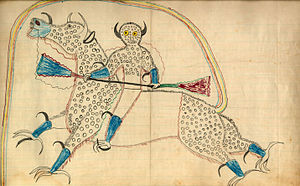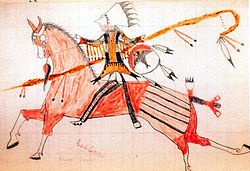I thought you might enjoy seeing it also.
,
Taken directly from Wikipedia, description of Ledger art:
"Historical precedents[edit]
Ledger art evolved from Plains hide painting.[1] Among Plains tribes, women traditionally paint abstract, geometrical designs, whereas men paint representational designs. The men's designs were often heraldic devices or visions painted on shields, tipis, shirts, leggings, or robes. Before the Plains tribes were forced to live on reservations in the 1870s, men generally painted personal feats in battle or hunting.[2] Plains ledger art depicted communally acknowledged events of valor and tribal importance in order to gain status for the individuals who participated in them, and their band and kin. Plains pictorial art emphasizes narrative action and eliminates unnecessary detail or backgrounds.[3] Figures tended to be drawn in hard outlines and filled with solid fields of color.[4]These were all traditionally painted on animal hides – particularly buffalo hides. When buffalo became scarce after eradication programs encouraged by the US federal government, Plains artists began painting and drawing on paper, canvas, and muslin.[1]New materials[edit]
An increasing supply of ledger books and other paper came from traders, government agents, missionaries, and military officers.[5] With these came pencils, ink fountain pens, crayons, and watercolor paints.[6] These new tools allowed for greater detail and experimentation than the earlier tools, such as bone or wood styli dipped in mineral pigments, had. The compact ledger books and pencils were highly portable, making them ideal for nomadic lifestyles.[7]Fort Marion[edit]
The most celebrated ledger artists were prisoners of war at Fort Marion in St. Augustine, Florida. In 1874, in what became known as the Red River War or Buffalo War, a group of Cheyenne, Kiowa, Comanche, Arapaho, and Caddowarriors fought the US Army to protect the last free herd of buffalo and to assert their autonomy.[8] In the harsh winter of 1874 to 1875, many tribal camps were forced to surrender to various Indian agencies, and the supposed leaders of the Red River War were rounded up and sent to Fort Marion.[9] From 1875 to 1878, the 71 men and one woman were under the command of Richard Henry Pratt, who used the opportunity to give the Indians a Western education.[10] He provided the prisoners with basic art supplies such as pencils, ink, crayons, watercolor paint, and paper.Twenty-six of the Fort Marion prisoners engaged in drawing. They were younger Cheyenne, Arapaho, and Kiowa men.[11] Some of the most prolific and well-known artists include Paul Caryl Zotom (Kiowa); David Pendleton Oakerhater or Making Medicine (Cheyenne); Tichkematse or Squint Eyes (Cheyenne); Wohaw (Kiowa); Howling Wolf (Cheyenne);Etahdleuh Doanmoe (Kiowa); White Bear (Arapaho); Koba (Kiowa); and Bear’s Heart (Cheyenne). Tichtematse, Howling Wolf, White Bear, and Koba all continued drawing after their release from prison.[12]Subject matter[edit]
Battle exploits dominated ledger art. Other traditional themes such as hunting, courtship,[13] and religious practices were common subjects. Ledger artists also documented their rapidly changing environment by portraying encroaching European Americans and new technologies such as trains and cameras. Many ledger artists worked with ethnologists, by documenting shield and tipi designs, ethnobotanical information, winter counts, dance customs and regalia, and other cultural information. Dreams and visions inspired ledger art just as they had inspired earlier hide paintings.[14]The artists creating ledger art today often reference pre-reservation lifeways, historical transitions, and social commentary. They use this style to illustrate cultural continuity between historical and contemporary Native life.[13]As fine art[edit]
Missionaries, anthropologists, and tourists eagerly collected ledger books in the late 19th century. Carl Sweezy (1881–1953) (Arapaho) and Haungooah (Silver Horn) (1860–1940) (Kiowa) both established professional careers as ledger artists.They inspired the Kiowa Five or, as they are increasingly known, the Kiowa Six. These artists painted with more sophisticated materials and met with international success when they exhibited their work in the 1928 International Art Congress in Prague,Czechoslovakia.Today[edit]
Numerous modern Plains artists create ledger paintings. Many seek out 19th-century documents on which to paint, creating ironic juxtapositions between the printed text and the paintings. Dwayne Wilcox (Oglala Lakota) uses the style of 19th-century Lakota painters to express humorous views of modern realities for Lakota people. Arthur Amiotte (Oglala Lakota) builds upon the collage aspect of ledger art and combines text, photography, naturalistic painting and stylized Plains pictorial art in his work.Dolores Purdy Corcoran (Caddo/Winnebago) is a female ledger artist who uses bright colors and female figures frequently in her work.[15]"
End wikipedia text







No comments:
Post a Comment